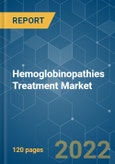The global hemoglobinopathies treatment market was studied and projected to grow with a CAGR of nearly 7% over the forecast period. The growth is primarily due to an increase in the cases of hemoglobinopathies, coupled with growing awareness pertaining to hemoglobin disorders. According to the World Health Organization, about 1.1% of the couples globally are at the risk of having a child with hemoglobin disorder and prevalence was estimated at 2.55 per 1000. In addition, the presence of strong product pipeline for the treatment of hemoglobinopathies and continuous efforts from the market players and government in developing the new therapies for the same are anticipated to boost the market growth. However, low awareness related to the hemoglobinopathies in low and some of the middle-income countries is anticipated to hamper the market growth. Moreover, the initiatives such as newborn screening for detection of potential disorders are lead by the government and private organizations are anticipated to fuel the market growth for hemoglobinopathies treatment.
Key Market Trends
Sickle Cell Anemia Anticipated to Grow at Significant Rate
- Sickle cell anemia refers to the group of blood disorders that cause misshape of red blood cells. This makes difficult for RBC to carry oxygen to different organs and tissues. Poor oxygen in the blood may lead to severe pain syndromes, necrosis and bacterial infections.
- The growing number of cases with sickle cell anaemia globally, coupled with the presence of a robust pipeline of drugs for the treatment of disease is anticipated to boost the segment growth over the forecast period.
- Drugs used for symptoms of hemoglobinopathies treatment include antibiotics, analgesics, ACE inhibitors. Further, Blood transfusion or stem cell therapy is one of the preferred treatments for hemoglobinopathies. Moreover, increasing research on the treatment of hemoglobinopathies such as gene therapies advancing the market growth.
- The World Health Organization has estimated that each year about 300000 babies are born with a severe form of inherited blood disorders, and 5% of the world population carries trait genes for haemoglobin disorders, mainly, sickle cell anaemia and thalassemia. Thus the growing incidence of hemoglobinopathies coupled with the rise in R&D investment for the development of treatment options expected to boost the market over the forecast period.
Europe is Anticipated to Have Significant Growth
Among the regional segments, Europe is anticipated to have significant market growth over the forecast period. The growth is attributed to a high number of hemoglobinopathies cases especially in Mediterranean countries, new product launches and growing awareness regarding the disorder. North America is anticipated to have notable market growth owing to well-established healthcare infrastructure for early diagnosis and treatment of hemoglobinopathies and initiatives by the government and non-government organizations to increase the awareness.
Competitive Landscape
Global hemoglobinopathies treatment market is moderately fragmented and competitive. Market players are focusing on new product launches, product innovations and geographical expansion. For instance, in May 2017, Sangamo Therapeutics and Pfizer announced a collaboration for the haemophilia A gene therapy. The key market players operating in the market include Sanofi S.A., Global Blood Therapeutics, Inc., bluebird bio, Inc. EMI Holding, Inc. and Celgene Corporation among others.
Additional Benefits:
- The market estimate (ME) sheet in Excel format
- 3 months of analyst support
This product will be delivered within 2 business days.
Table of Contents
Methodology

LOADING...








